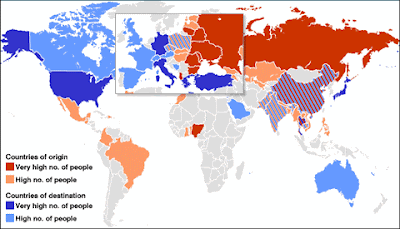
Japan is a destination and transit country for men, women, and children trafficked for the purposes of commercial sexual exploitation and forced labor. Women and children trafficked to Japan for commercial sexual exploitation come from the People’s Republic of China, South Korea, Southeast Asia, Eastern Europe, Russia, and, to a lesser extent, Latin America. Japan is a transit country for persons trafficked from East Asia to North America. The majority of identified trafficking victims are foreign women who migrate to Japan seeking work, but are subjected upon arrival to debt bondage and forced prostitution. Male and female migrant workers are subjected to conditions of forced labor. Traffickers use debt bondage to exploit women in Japan’s large sex trade, imposing debts of up to $50,000. In addition, trafficked women are subjected to coercive or violent physical and psychological methods to prevent them from seeking assistance or escaping. Traffickers also target Japanese women and girls for exploitation in pornography or prostitution. Many female victims, both foreign and Japanese, are reluctant to seek help from authorities for fear of reprisals by their traffickers, who are often members or associates of Japanese organized crime syndicates (the Yakuza). Japanese men continue to be a significant source of demand for child sex tourism in Southeast Asia.
The Government of Japan does not fully comply with the minimum standards for the elimination of trafficking; however, it is making significant efforts to do so. While Japan continued to implement reforms through its Inter-Ministerial Liaison Committee on trafficking in persons, the government’s efforts to identify and protect victims of trafficking remained inadequate. In addition, prosecutions decreased from the previous year. Law enforcement authorities and other officials did not systematically employ formal victim identification procedures, resulting in the government’s failure to recognize many trafficking victims. The number of victims identified and assisted by Japanese authorities fell for the second year in a row, but based on calls to victim hotlines and interviews with victims, NGOs and researchers believe the number of actual victims exceeds government statistics. Some observers attribute the decline in identified victims to the difficulty of investigating sex businesses that are increasingly moving underground due to police crackdowns on red-light districts in major cities. This increased pressure from law enforcement has eliminated visible prostitution and forced many sex businesses to thinly disguise prostitution as “delivery health” (escort) services.
Prosecution
There was no improvement in the Government of Japan’s efforts to address sex trafficking through law enforcement during the reporting period, and the government failed to address the problem of trafficking for labor exploitation. Prosecutions for sex trafficking decreased in 2007, as 11 sex trafficking cases were prosecuted, and 12 trafficking offenders were convicted, compared to 17 prosecutions and 15 convictions in 2006. Of the 12 convictions in 2007, seven offenders received prison sentences of two to four years with labor; five offenders received suspended sentences. The only labor trafficking convictions in 2007 were for two cases prosecuted under the Labor Standards Law. While Japan does not have a comprehensive anti-trafficking law, a variety of laws, including the 2005 amendment to the criminal code, the Labor Standards Law, the Employment Security Law, the Prostitution Prevention Law, the Child Welfare Law, and the Law for Punishing Acts related to Child Prostitution and Child Pornography, cover most, but not all forms of trafficking. Specifically, Japanese law does not prohibit recruitment of laborers using knowingly fraudulent or deceptive offers for purposes of forced labor. Labor exploitation was widely reported by labor activists, NGOs, shelters, and the media. The Immigration Bureau and Labor Standard Inspection Bodies reported hundreds of abuses of the Industrial Trainee and Technical Internship Program (the “foreign trainee program”). Reported abuses included fraudulent terms of employment, debt bondage, restrictions on movement, and withholding of salary payments. While the majority of companies employ foreign trainees appropriately, participants in the first year of the three-year program were not protected by labor laws and were therefore vulnerable to trafficking. In addition, such exploitation was not limited to participants in the first year of the program. There were only two convictions for labor trafficking during the past two years despite Labor Standard Inspection Bodies having identified more than 1,209 violations of labor laws in 2006 alone, indicating a serious lack of will by the government to enforce these laws. The government did make some efforts to address oversight of the foreign trainee program. The Ministry of Justice released a list of prohibited acts to govern the program, but there were no criminal penalties for companies found in violation of the regulations. The Cabinet approved provisions to reform the program, including applying the Labor Standards Law to the first year; but, these provisions had not yet taken effect or even been debated by the Diet during the reporting period. These measures are unlikely to have any effect on the problem without a significant increase in enforcement of labor laws.
[1]
Protection
Despite the government’s increased efforts, victim protection remained inadequate during the reporting period. The number of trafficking victims identified by the Japanese government declined for the second consecutive year. Law enforcement authorities identified 43 victims in 2007, down from 58 in 2006 and 116 in 2005. This number is disproportionately low relative to the suspected magnitude of Japan’s trafficking problem. Although some observers speculate there are fewer victims identified because sex trafficking may have decreased in Japan, it is more likely the move of many sex businesses underground has made it more difficult for police to investigate and rescue potential victims. NGOs working with trafficking victims continue to assert the government is not proactive in searching for victims among vulnerable populations such as foreign women in the sex trade or migrant laborers. Of particular concern was the Japanese government’s repatriation of 16 of the 43 identified trafficking victims without referring them to IOM for risk assessment and formal repatriation processing. Although police and immigration authorities take part in regular training programs, Japan has not adopted formal victim identification procedures, nor does it dedicate government law enforcement or social services personnel specifically to the human trafficking issue. During the reporting period, police and immigration authorities failed to consistently identify trafficking victims. Officials from third-country embassies reported Japanese police and immigration officers failed to recognize their citizens as trafficking victims, forcing the embassies to take charge of victim repatriation. In addition, the government did not recognize any victims of labor trafficking during the reporting period in spite of widespread reports of labor exploitation by both official and private entities. Forty of the 43 identified trafficking victims in 2007 were provided services by government shelters— Women’s Consulting Centers (WCCs)—located in each of Japan’s 47 prefectures. The victims had access to subsidized medical care and some victims received psychological care while in the WCCs. However, the large majority of trafficking victims did not have adequate access to trained psychological counselors with native language ability, a weakness the Japanese government is now beginning to address. The Ministry of Health, Labor, and Welfare surveyed the NGO community to identify interpreters with experience or training in providing counseling and psychological care to victims of trafficking, and has begun to make this information accessible to WCCs nationwide. Although the government asserts that legal assistance is available to all trafficking victims, a survey of WCC operators indicated that neither WCC staff nor victims were consistently aware free legal assistance was available. To date there have been no cases where the government actually provided legal assistance to a trafficking victim. Although victims were eligible for special stay status as a legal alternative to repatriation in cases where victims would face hardship or retribution, NGOs report most victims were unaware they could extend this status or apply for a change of status to one which permits employment. Moreover, there has never been a case of a victim staying in Japan for more than a few months. The lack of native language counseling, the isolation of victims from fellow nationals and other trafficking victims, and the lack of alternatives—particularly any option to work or generate income while in Japan—led most victims to choose an expeditious repatriation to their home country. Although the government encouraged victims to assist in the investigation and prosecution of trafficking crimes, it did not provide victims with an environment conducive to cooperation. Japan gave $300,000 to IOM in 2007 for repatriation and reintegration assistance, and budgets about $100,000 each year for subsidizing victims’ care in private NGO shelters that specialize in assisting trafficking victims.
Prevention
The Government of Japan demonstrated strong efforts to raise awareness about some forms of trafficking during the reporting period. The government took efforts to reduce the demand for commercial sexual exploitation through the distribution of 500,000 brochures on the trauma of trafficking, government anti-trafficking efforts, and how to receive victim assistance. The government also produced 25,000 trafficking awareness posters portraying the link between prostitution and trafficking in persons. The posters and brochures were distributed to immigration offices, police stations, and foreign embassies and consulates throughout Japan. The government donated $79,000 to a Thai NGO to construct a dormitory for Thai students vulnerable to trafficking. A significant number of Japanese men continue to travel to other Asian countries, particularly the Philippines, Cambodia, and Thailand, to engage in sex with children. Although the Act on Punishment of Activities Relating to Child Prostitution and Child Pornography and the Protection of Children provides Japanese courts with extraterritorial jurisdiction over Japanese nationals who have sexual intercourse with a minor in a foreign country, the government has not prosecuted a Japanese national for child sex tourism since 2005. During the reporting period, the government did not take any steps to specifically reduce the demand for child sex tourism by Japanese nationals. Japanese law does not criminalize the possession of child pornography, and this continues to contribute to the demand for commercial sexual exploitation of children and child sex tourism. According to National Police Agency statistics, 773 Japanese children were either prostituted or exploited in child pornography during the first half of 2007. Japan has not ratified the 2000 UN TIP Protocol






No comments:
Post a Comment